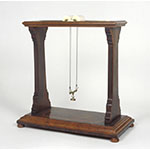This apparatus, now incomplete, was described by Jean-Antoine Nollet in Leçons de physique expérimentale (Paris, 1743-1748) as a device for demonstrating the properties of the wedge; a similar instrument was also illustrated by Willem Jacob 's Gravesande and Theophilus Desaguliers. A rectangular wooden base supports a frame with a rectangular opening at the top. Two metal wires, stretched along the edges of the aperture, act as rails for two ivory rollers mounted on wheels. To separate the rollers, it is necessary to overcome a force proportional to their weight. The missing part of the apparatus consisted of three small hinged boards forming a variable-angle wedge inserted between the rollers and weighted down with a load. The apparatus demonstrates that the weight exerted on the wedge makes it possible to separate the rollers and lift another weight whose magnitude is inversely proportional to the angle formed by the wedge. Provenance: Lorraine collections.









